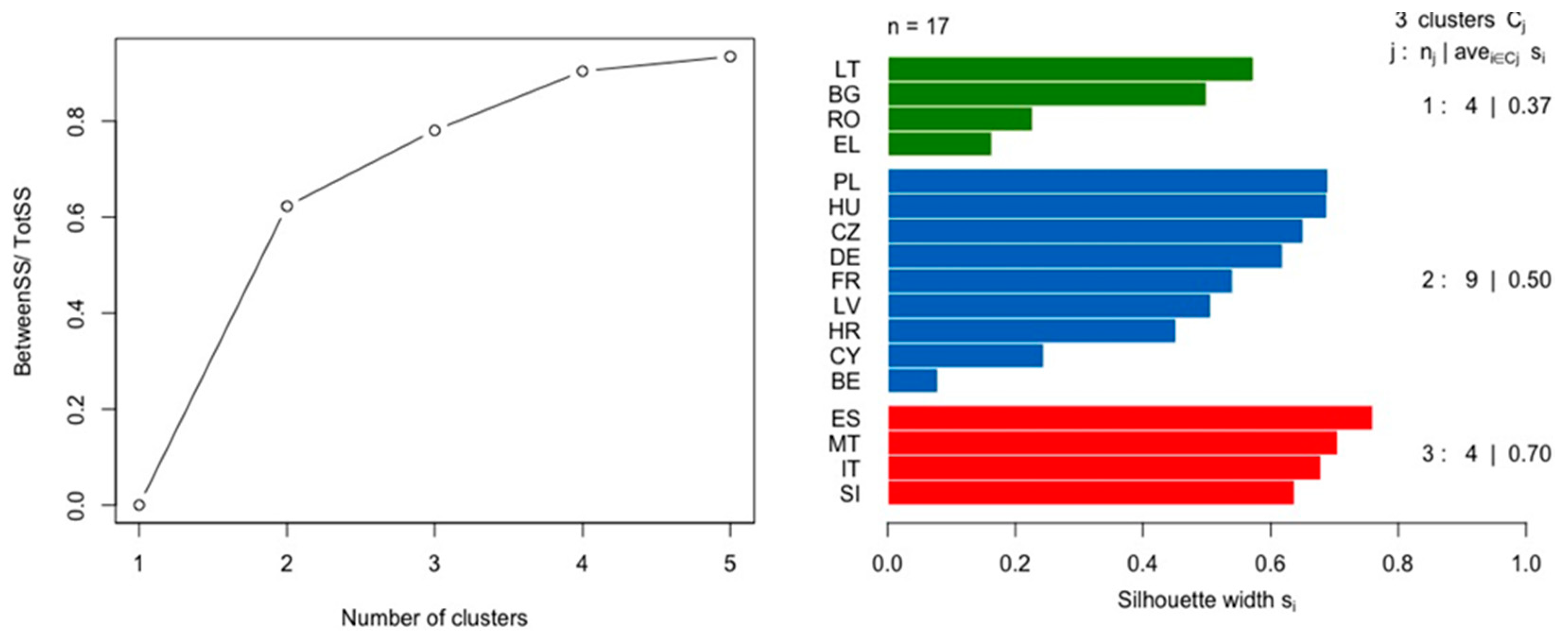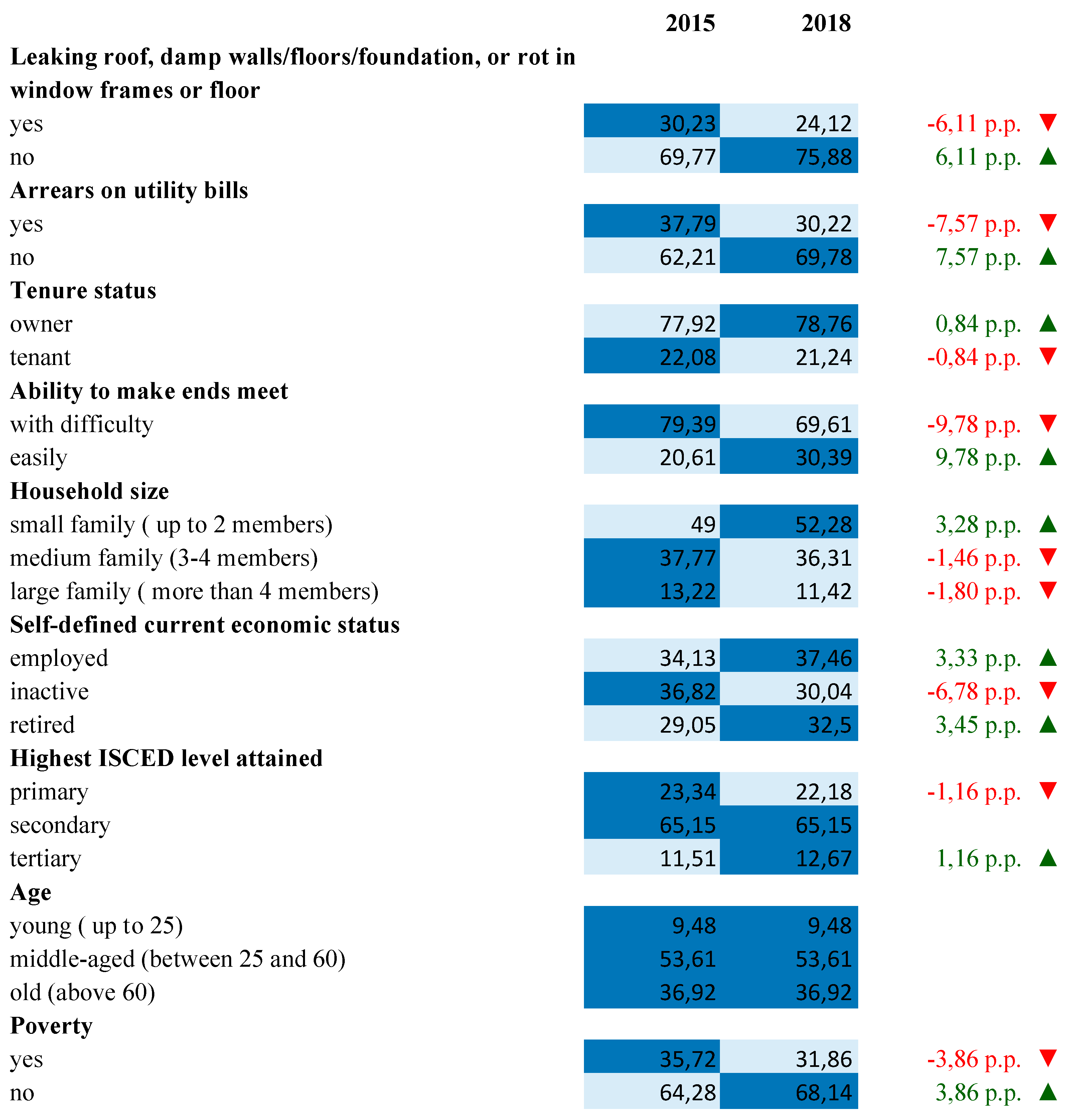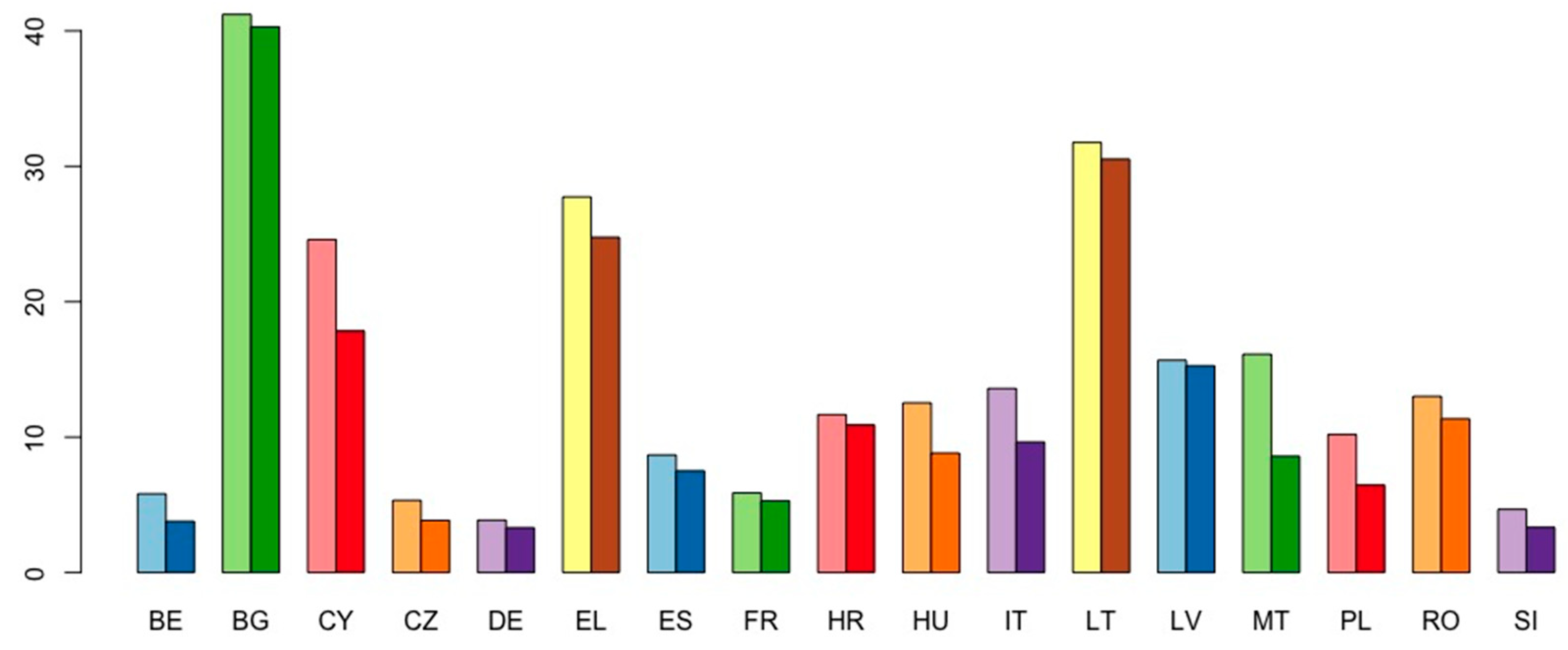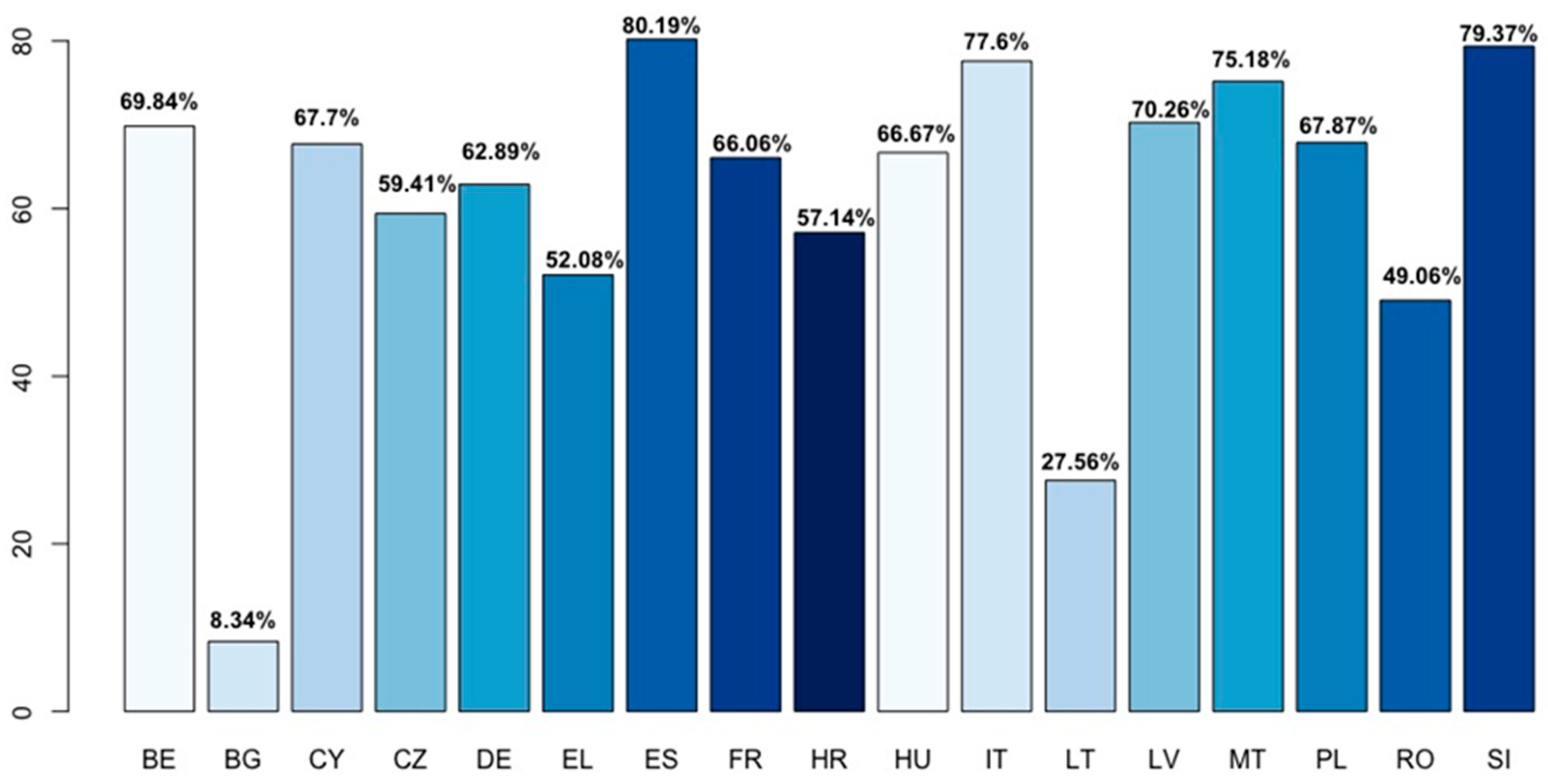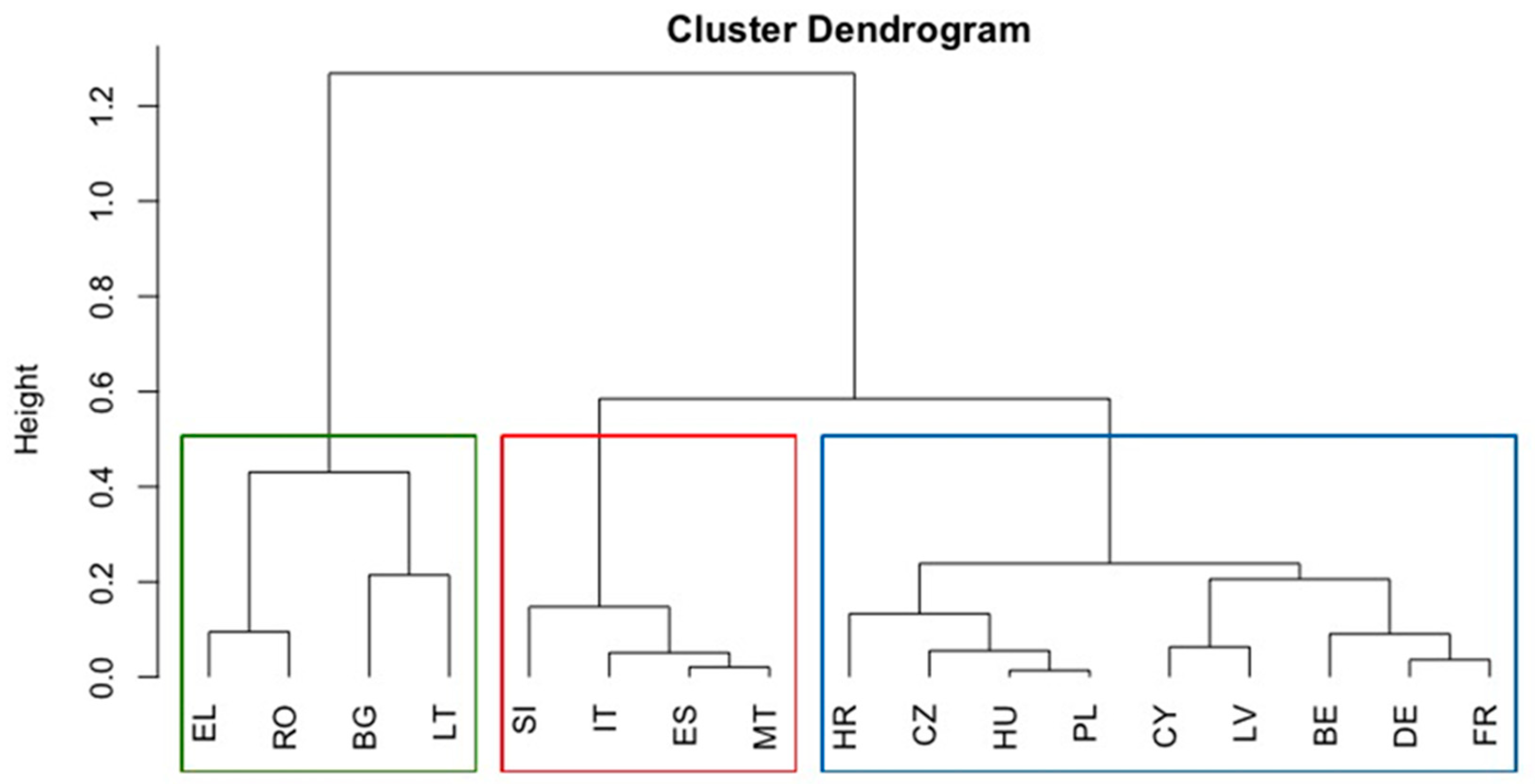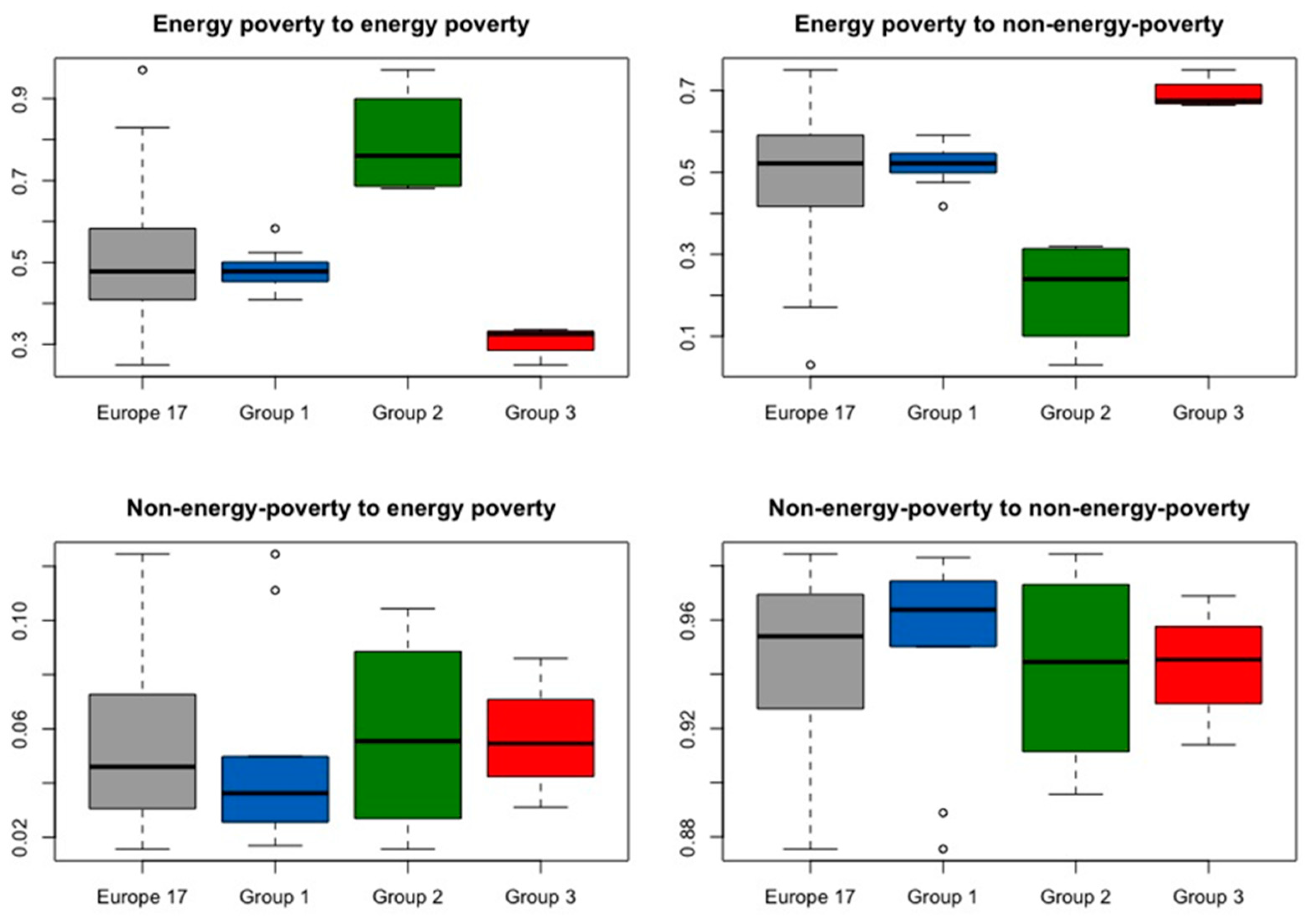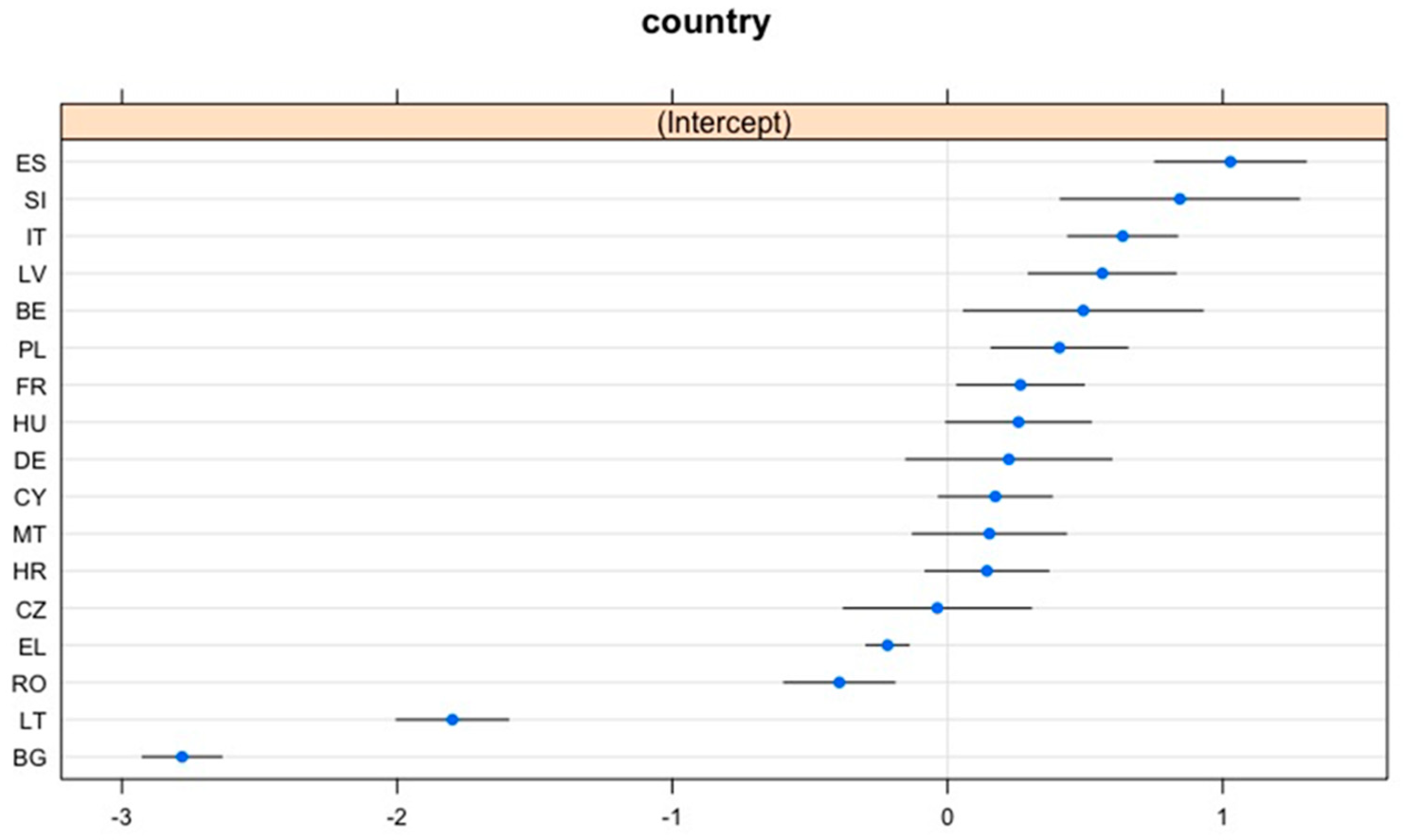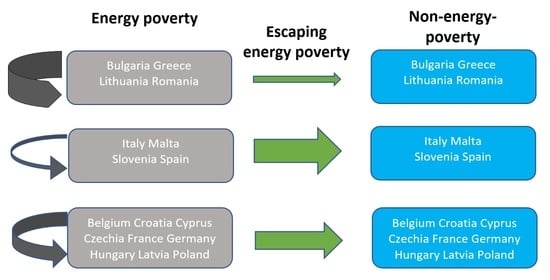1. Introduction
Facing the transition to a carbon-neutral economy, in 2019 the EU adopted a set of legislative acts entitled the Clean Energy for all Europeans Package. Recognizing the importance of clean energy for economic growth and job creation (COM/2016/0860), EU countries joined their efforts to boost the creation of the Energy Union. A series of policy actions on counteracting energy poverty were adopted in EU countries [
1] following the Clean Energy for all Europeans Package. With the interest of consumers being placed at the center of the redesigned energy market, the EU committed to energy poverty alleviation and the protection of vulnerable consumers (Energy Poverty 2020). In general terms, energy poverty is defined as a lack of access to modern energy services, however, the precise definition of energy poverty depends on the measurement technique. In our study energy poverty denotes the inability to keep home warm. The Governance Regulation (Regulation (EU) 2018/1999) and the Electricity Directive (Directive (EU) 2019/944) oblige member states to measure, monitor, and report on the assistance to energy-poor households, and to outline policy actions supporting the energy poor in the national energy and climate plans, especially in countries with a significant number of the energy poor. As reported by the EU Energy Poverty Observatory (2020), about 50 million households are at present facing challenges of energy poverty. The recent analysis of the structural energy poverty vulnerability [
2] identifies those regions and countries on the EU map in which the problem is particularly acute.
The initiatives aimed at energy poverty reduction at the EU level necessitate a thorough understanding of the nature of energy poverty in all member states. While there are plenty of studies on energy poverty prevalence, both single-country [
3,
4,
5] and comparative studies [
6,
7,
8], the cross-country assessment of energy poverty persistence in Europe has not been done yet. In particular, it is not known whether the persistence of energy poverty is the same or different in all European countries. Detecting potential differences in the persistence of EP enables a better understanding of the phenomenon, identifies factors that facilitate the escape from EP, and identifies effective social policy tools used by different EU countries. We intend to cover this gap. We examine the persistence of energy poverty in 17 European countries, giving European politicians new insights into how energy poverty is developing in the perspective of four years. The following countries are considered: Belgium (BE), Bulgaria (BG), Croatia (HR), Cyprus (CY), Czechia (CZ), France (FR), Germany (DE), Greece (EL), Hungary (HU), Italy (IT), Latvia (LV), Lithuania (LT), Malta (MT), Poland (PL), Romania (RO), Slovenia (SI), and Spain (ES). The study answers two research questions:
- (1)
How difficult is it for households in 17 European countries to escape energy poverty?
- (2)
What factors determine success in escaping energy poverty?
There are two reasons behind the study. First, by providing evidence on energy poverty persistence in Europe, the analysis can be beneficial in formulating high-level policy and long-term strategies within the EU. Energy poverty, as well as poverty, is a stochastic phenomenon [
9]. The level of energy poverty measured at a point of time provides no information on how easily the problem can be overcome and how European countries differ in terms of energy poverty persistence. Second, by identifying universal factors triggering escape from energy poverty, the study helps to find common points in national energy poverty policies. Focusing on the energy poor households from all countries, we could detect what helps them to get out of the predicament and, at the same time, capture the variation attributed to the among-country random effect.
Although member states define and measure energy poverty at their discretion, several suggested indicators and definitions are published [
10,
11] and recommended by the European Commission (2020/1563). The best known measures of energy poverty include expenditure-based and subjective indicators [
12]. In this study, we rely on a subjective energy poverty indicator, i.e., the inability to keep homes warm, following the approach indicated by, among others, the European Commission (2020) and the Council of Europe Development Bank (2019). The ability-to-keep-home-warm indicator belongs to subjective metrics and is available in the EU-SILC database, i.e., the major source of the primary consensual energy poverty indicators in the EU. This indicator is frequently used in the comparative analysis of energy poverty in Europe [
8,
13]. Being aware of the drawbacks of subjective indicators, such as biasness [
14] or inconsistency, we believe the inability-to-keep-home-warm indicator reveals people’s perceptions and is useful in studying complex issues [
15] in multiple locations. This indicator does not require additional assumptions or expert-based assessment [
16], which might be different for different countries and provides the best fit for the data and the purpose of our analysis.
The analysis is carried out in two steps following the research questions of the study. We use panel data from the EU-SILC questionnaire collected by Eurostat on an annual basis. Our choice of countries is determined by the availability of variables and the size of the energy-poor households sample in a base year. Only countries with more than 100 energy-poor households in 2015 are considered.
In the first step, we focus on all households from each country separately and analyze two states in which households can stay: energy poverty and non-energy poverty, and then examine the chances of moving between them. The transition probability in each country is estimated using the discrete-time Markov process. We assess the persistence of energy poverty as the probability to remain in the same condition in 4 years. The first-step transition probability matrices obtained are next used in the clustering procedure. To identify groups with similar transition paths we apply hierarchical and k-means clustering.
In the second step, we look at energy-poverty households from all countries and identify the factors that help these households move from energy poverty in four years. In identifying the determinants of escaping energy poverty, the study relies on the binomial mixed-effect regression. To account for the differences between countries, we include a varying among-countries intercept as a random effect of the model. We control for poverty, building characteristics, age, education, employment status, size of the family, and tenure status.
Our main findings confirm regional differences within Europe in terms of energy poverty persistence. Three groups of countries with similar transition probability paths are discovered, of which Bulgaria, Greece, Lithuania, and Romania are of special concern. The average probability of staying in energy poverty in Europe is 51.5%. We recommend policy makers to pay close attention to the energy poverty retention rate, which signifies a greater probability to stay than to escape. The study confirms that non-poverty and housing energy efficiency are the major forces that drive escapes from energy poverty in Europe.
The study is divided into six sections. Apart from
Section 1, where we introduce the topic, in
Section 2 we provide the literature review, while in
Section 3 we describe our data and present preliminary statistics. We explain the methodology used in
Section 4, report the results in
Section 5, and offer conclusions in
Section 6.
2. Literature Review
The first strand of literature focuses on energy poverty prevalence across Europe. This type of analysis mainly relies on the EU-SILC dataset and uses subjective measures of energy poverty, such as the ability to keep homes warm, leaks/damp/rot in a dwelling, and arrears on utility bills [
13]. Expenditure-based indicators in comparative energy poverty analysis are rare and require additional assumptions [
17]. Macro-level energy poverty comparisons draw upon data on energy consumption in the residential sector [
7]. Some studies use composite measures of energy poverty [
8,
18], others rely on multiple socio-economic factors in evaluating the countries’ resilience towards energy poverty [
19] or structural energy poverty vulnerability [
2]. The research on energy poverty prevalence is dominated by static analyses. The major drawback of static analysis is the lack of a forward-looking perspective on how the predicament unfolds.
The second strand of the literature concentrates on the dynamics of energy poverty. This group of studies is not so numerous but is rapidly developing and is always country specific. To the best of our knowledge, the UK [
20,
21], Spain [
22], and France [
23] have been the subject of the energy poverty dynamic analysis. We also account for dynamic energy poverty modeling performed by [
24,
25,
26,
27,
28]. Different types of statistical tools are used in the analysis of energy poverty persistence, such as the mover-stayer model [
23], dynamic probit estimator [
27], Markov process [
22], discrete hazard models [
20], logistic regression [
21], etc. Most studies rely on custom-based surveys and are dedicated to one country.
The analysis we propose here belongs to both streams of research. Our study is the first to provide evidence on several aspects of energy poverty persistence. First, we track the energy-poverty mobility of households in many European countries and compare the results by using clustering techniques. The study demonstrates how different the analyzed countries are in terms of energy poverty persistence. Second, we identify factors that help the energy-poor households from all countries to leave energy poverty in 4 years. This is possible with the mixed effect model that allows us to control for the country grouping effect while combining the data from multiple countries in one sample.
Our study builds off the works in which a micro-level approach is applied in comparative energy poverty research [
6]. We further extend the paper by [
29] on the persistence of energy poverty in Europe by considering the factors that have an impact on escaping energy poverty and account for the probability of moving between energy poverty and non-energy poverty. We contribute to the literature on energy poverty determinants. Authors list the following determinants of energy poverty: energy efficiency of houses [
30], energy prices [
27,
31], behavior [
32], and a mixture of different socio-economic factors [
33]. Our study moves beyond the traditional single-country approach and points to the determinants common for all energy-poor households in 17 European countries, thus paving the way for more detailed comparisons between countries.
3. Data Description
Our study uses the latest available EU-SILC longitudinal data collected in 2015–2018 for 17 European countries. The survey is administered by Eurostat and compiles information on, e.g., poverty, social exclusion, and housing conditions. The survey is harmonized across participating countries. Each panel consists of household data and personal data files. Panels track household and individual changes over four years. All panels are balanced. The personal data file contains additional variables of household members not available at a household level. For our analysis, we select 7 variables from among household data, i.e., ability to keep the home warm (HH050), ability to make ends meet (HS120), arrears on utility bills (HS021), household size (HX040), leaks/damp/rot in a dwelling (HH040), tenure status (HH021), equivalized disposable income (HX090), and 3 variables from among personal data, i.e., self-defined current economic status (PL031), age (PB140), the highest ISCED level attained (PE040). The variables are the determinants of energy poverty identified in the previous analysis [
17] and discussed in the literature [
25,
30,
34]. We include two groups of indicators, i.e., households’ socio-economic characteristics and buildings’ parameters [
35]. The quality of a building determines the energy efficiency and has an impact on the vulnerability of a household to energy poverty [
16]. What is more, some authors claim that housing conditions are the main trigger for self-reported energy poverty [
22].
The sample size varies between countries depending on the respective EU regulation (Regulation 1177/2003). The smallest sample is collected from 850 households (Malta) and the biggest sample is collected from 5364 households (Greece). The total number of households considered in the analysis is 35,957, of which 10,150 declare energy poverty in the first wave of the observation period. Although the EU-SILC longitudinal data are available for more than 25 European countries, we account only for the countries which reported more than 100 energy-poor households in 2015.
Figure 1 shows the frequency distribution of categorical variables for 10,150 households classified as energy poor in 2015. Statistics for the first and the last survey period are compared, the difference measured in percentage points is provided in the last column. In the heatmap, the more intense color corresponds to the highest frequency values. The share of households that have leaks/damp/and rot in a dwelling, arrears on utility bills, difficulties with making ends meet, and are income poor in 2015 decreases in 2018. Those households are mostly represented by medium-sized families with middle-aged members with secondary education. Surprisingly, the majority of energy-poor households are not classified as the poor in terms of their income. The share of owners is quite high, whereas the economic status is almost equally distributed among employed, professionally inactive, and retired people.
The energy poverty rate is computed based on the ability-to-keep-home-warm indicator. As depicted in
Figure 2, Bulgaria, Latvia, and Greece have the highest incidence of energy poverty. By contrast, Germany, Slovenia, and Czechia have the lowest energy poverty rate.
Figure 3 shows the energy poverty escape rate. The escape rate is calculated as a share of households that are energy poor in the first wave, but move out of energy poverty in the last wave. The high escape rate signifies the instability of the phenomenon in the period of four years. The highest value is noted in Spain and the lowest in Bulgaria.
Table 1 contains descriptive statistics of the energy poverty rate and energy poverty escape rate for all 17 countries. Overall, the rate of energy poverty decreases in 2018 compared to 2015. The high standard deviation of the energy poverty escape rate indicates that the values are less concentrated around the mean.
Our set of variables contains one continuous variable, i.e., equivalized disposable income. We use this variable to compute the poverty threshold, which is 60% of a national median equivalized disposable income. The respective boxplot distribution of equivalized disposable income in 2015 and 2018 is presented in
Figure 4. There are no significant changes in income distribution in 2015 and 2018. Two groups of countries, the ones with low and high income, can be easily identified. The median value slightly increases from 9262.22 euros in 2015 to 10,008 euros in 2018. As mentioned above, only a small group of the energy-poor households, i.e., 35.72% in 2015 and 31.86% in 2018, are considered poor according to the standard poverty measure. This fact could be attributed to the discrepancy of classifications produced by subjective and objective indicators. In this study, poverty is included in the model as a determinant of escaping energy poverty.
5. Results and Discussion
First, we estimate the transition probabilities of moving out and into, as well as staying in, energy poverty and non-energy poverty states in each country. The results are presented in
Table 2. A one-step transition probability matrix is a collection of all probabilities in a single step. The persistence of energy poverty can be assessed by the respective retention rate, i.e., the rate of returning to the same condition in the observed period. Additionally, the transitioning to energy poverty should be taken into account. The average energy poverty retention rate in all selected countries is more than 51%; the average probability of entering energy poverty is 5.4%. Statistics demonstrate that there are slightly more chances to remain in energy poverty than to escape it. Although, the average probability of transitioning to non-energy poverty is almost 9 times higher compared to the probability of moving to energy poverty, yet the high retention rate signifies problems households have with escaping energy poverty within four years.
The maximum value of the energy poverty retention rate is noted in Bulgaria (97%) and the minimum in Slovenia (25%). The results point to striking differences between European countries. In some countries, energy poverty seems to be unstable in the long run, whereas in others it is very difficult to escape energy poverty. In line with [
23], we indicate that French households have a higher probability to leave energy poverty than to stay in it. Our results differ from the conclusions drawn by [
22], who claim that the state of energy poverty in Spain measured by a subjective indicator is more pervasive. According to our results, and in comparison to other countries of Europe, Spain is better off in terms of energy poverty persistence. A possible difference results from the measurement technique used and the data span which—in the case of [
22]—is close to the global financial crisis period that might have an impact on the ubiquity of energy poverty. The distribution of transition probability is an interesting point to consider in discussing the long-term policy effects.
Transition paths in groups of countries show some similarities. Based on
Table 2, we group countries minimizing the total within-cluster variance. As demonstrated in
Figure 5, 3 distinct groups are identified. The first group consists of 9 countries (Belgium, Croatia, Cyprus, Czechia, France, Germany, Hungary, Latvia, Poland), while the second (Bulgaria, Greece, Lithuania, Romania) and the third (Italy, Spain, Malta, Slovenia) of 4 countries each. The results are robust to alternative k-means clustering technique (
Figure A1). The suggested optimal number of clusters is 3–4. The same groups are obtained in 3-cluster partitioning.
Figure 6 presents the distribution of transition probabilities in each group and all 17 countries. The results obtained in Group 1 are close to Europe-17. Several outliers are identified in this group, such as Croatia, in which the energy poverty retention rate is 58.3%, and Cyprus and Lithuania, in which the chances to transit into energy poverty are high, i.e., 12.4% and 11.1%, respectively. Group 1 is also characterized by small overall dispersion, which means that member countries of this group share a lot of similarities in terms of their transition probability. Groups 2 and 3 have rather dissimilar distributions, especially the ones concerning energy poverty transitions. We could say that in Group 2 energy poverty appears to be more persistent. Furthermore, there is high variability in non-energy poverty probabilities among countries from Group 2, as shown by the interquartile range. Countries in Group 3 are better off in terms of energy poverty persistence. By contrast, movements from non-energy poverty to energy poverty are more intensive in Group 3 than in Group 1.
Second, we examine the determinants of escaping energy poverty in a four-year time perspective by building a binomial mixed effect model. In this part, our sample is limited to household members that declare problems with keeping the home warm in the base year 2015. Our response variable indicates successful energy poverty escape if a household changes its status from unable to keep the home warm in 2015 to able to keep the home warm in 2018. Factors that have an impact on escaping energy poverty are included in the model, and we also construct several “happy” scenario variables that indicate positive changes happening to household members in 2018. Positive changes are associated with getting income, i.e., the change of economic status from being inactive to active or retired, with renovation, i.e., having no leaks/damp/rot, and with being able to make ends meet and settle arrears on utility bills in 2018 compared to 2015. Variables indicating favorable changes are frequently used in modeling poverty dynamics [
44,
45].
The results of the mixed-effect regression are presented in
Table 3. The overwhelming majority of fixed effect variables are very significant. The age variable is a rare exception. We observe that good (with no leaks/damp/rot) or renovated buildings, tertiary and even secondary education, owner tenure status, living in a large family, and employment significantly increase the probability of exiting energy poverty. Tenants have limited possibilities to invest in house renovation compared to owners. By sharing a house, large families can save on energy costs. Poverty, measured by either income-based or subjective indicators, impedes the ability to escape energy poverty. Young age is positively associated with the ability to get out of energy poverty. The results also reveal the high significance of positive changes, particularly of the ability to make ends meet. Our study supports the evidence provided by [
21], that one-person households and old age, among others, decrease the probability to move out of energy poverty. In addition, the strong impact of house renovation and employment on the ability to leave energy poverty is also confirmed by [
23]. In our model, the status of a tenant impedes energy poverty escapes. As reported in the literature, rented housing is usually associated with energy poverty and a wide range of structural disadvantages [
46].
Figure 7 shows the distribution of varying intercepts across countries, which is a grouping factor in our model. Consequently, 17 conditional modes of the random effect are extracted from the model. In general, the distribution of intercepts corresponds to the hierarchical clustering results conducted on the basis of transition probability paths. While the majority of countries have a positive value of the intercept, some countries, such as Bulgaria, Lithuania, Romania, and Greece, stand out. The among-countries standard deviation of the intercept is 0.93. To test the significance of the country’s random effect, we use the likelihood-ratio test of the full model (model 2) and the reduced model (model 1), i.e., the model without country variable.
Table 4 shows that adding country random effect results in a much better model.
The country’s random effect could be attributed to geographical factors, such as climate, a level of socio-economic development, and a degree of urbanization, which play a non-negligible role in energy poverty persistence [
20].
Not all 17 countries contain variables that might be useful for the analysis. To estimate the significance of some missing variables, such as regions (DB040), degree of urbanization (DB100), dwelling type (HH010), year of contract or purchasing or installation (HH031), and a number of rooms (HH030), we include these variables and shrink the number of countries in a dataset to 14. We exclude Germany, Slovenia, and Latvia, reducing the total number of observations by 5.6%. The new dataset consists of 9573 households. The results of the mixed model for 14 countries are presented in
Table A1. The second mixed effect model has two grouping factors, i.e., country and region. Except for the new installation, the added variables carry small or negligible significance. The among-regions standard deviation of the intercept is 0.49. We apply the same test of the random effect significance. This time, we exclude the region variable from the reduced model. The ANOVA output provides evidence that including regions would significantly improve the model (
Table A2). However, we should account for the low representation in the vast majority of regions, which might distort the results. In light of the above arguments, we conclude that the initial set of countries and variables provides a good fit to the model.
6. Conclusions
This study focuses on the persistence of energy poverty in 17 European countries by considering the transition probability paths of households in each country. We rely on the latest available longitudinal data from the EU-SILC, waves 2015–2018, and use the subjective energy poverty indicator, which is the ability to keep homes warm. This indicator allows for applying a uniform approach to measuring energy poverty in countries having different socio-economic environments. The subjective energy poverty measure does not require additional assumptions or thresholds tuning. The persistence of energy poverty is understood as a probability of staying in the same condition in 4 years. Following the DTMC process, we discover three groups of countries that have similar patterns of moving in and out of two states: energy poverty and non-energy poverty. The grouping results are robust to alternative k-means clustering.
The analysis helps to understand the dynamics of energy poverty in 17 countries. The results suggest that households in some countries face serious problems in transitioning from energy poverty. For example, in a group of Bulgaria, Greece, Lithuania, and Romania, we observe the highest energy poverty retention rate compared to other groups. On average, the chances to remain in energy poverty in this group equal 80%, which signifies that the situation is close to the energy poverty trap. By contrast, in the group of Italy, Malta, Spain, and Slovenia, the average probability of moving out of energy poverty (31%) is the lowest among all groups. The average retention rate of energy poverty in the remaining countries (48.4%) is close to the European average results (51.5%). The high value of the interquartile range of the energy poverty retention rate (72%) points to a great disparity between countries in terms of energy poverty persistence. The lack of cohesion within the European countries and a clear division into groups should be further considered in the European region and energy poverty policy.
The study also examines the factors that trigger energy poverty exits in a 4-year time perspective in households classified as energy poor at the beginning of the observation period. This part of the analysis is based on a dataset consisting of 10150 observations from all countries. Regression results from the mixed effect model reveal a strong effect of the among-country varying intercept. The determinants of escaping energy poverty include, e.g., housing conditions, poverty, employment, education, and tenure status. Most variables have a high significance. Young age, ability to make ends meet, and higher education are positively associated with the chances to exit energy poverty. Poverty and renovation of the building are the positive changes that exert the greatest impact on the chances to escape energy poverty. Policy makers may consider the key determinants of escaping energy poverty in formulating policies aimed at energy poverty alleviation.
We would like to convey several messages to policy makers. First, the level of energy poverty computed for each country should be accompanied by persistence analysis. In a four-year period, in many countries energy poverty is not a stable state, whereas in others the situation is almost a trap. The persistence of energy poverty determines policy mechanisms. Second, we suggest relying more on short-term policy actions and preventive measures in countries where energy poverty is less persistent. For example, short-term actions might include houses renovation and raising public awareness, etc. In countries where energy poverty is hard to escape, long-term strategies and complex policies improving socio-economic situation, i.e., employment and taxation, should be a priority. Short- and long-term policies should be combined in both cases. Third, the regional disparity between European countries point to a lack of cohesion within the EU. Some countries, such as Greece, Bulgaria, Lithuania, and Bulgaria, are much worse off when it comes to the persistence of energy poverty. EU regional policy is one of the instruments suitable to tackle the issue. Fourth, we identify the determinants of energy poverty escapes common to energy-poor households from all analyzed countries. Demographic, technical, and socio-economic factors are the drivers in escaping energy poverty, which suggests common EU policy. EU-wide policies aimed to improve these factors can be effective in combating energy poverty in all countries. Fifth, the dynamics of energy poverty should be monitored on a regular basis as it offers a valuable insight into the effectiveness of the respective policies and provides a forward-looking policy perspective.
The limitation of this analysis is related to the availability of data. Although the EU-SILC is harmonized across many European countries, there are differences in datasets. In order to conduct the mixed-effect regression analysis, we have to select countries that contain more than one hundred energy-poor households in the initial period, which also limits the number of countries. Further studies on this topic may include the analysis of energy poverty profiles and the determinants of escaping energy poverty in each country.
